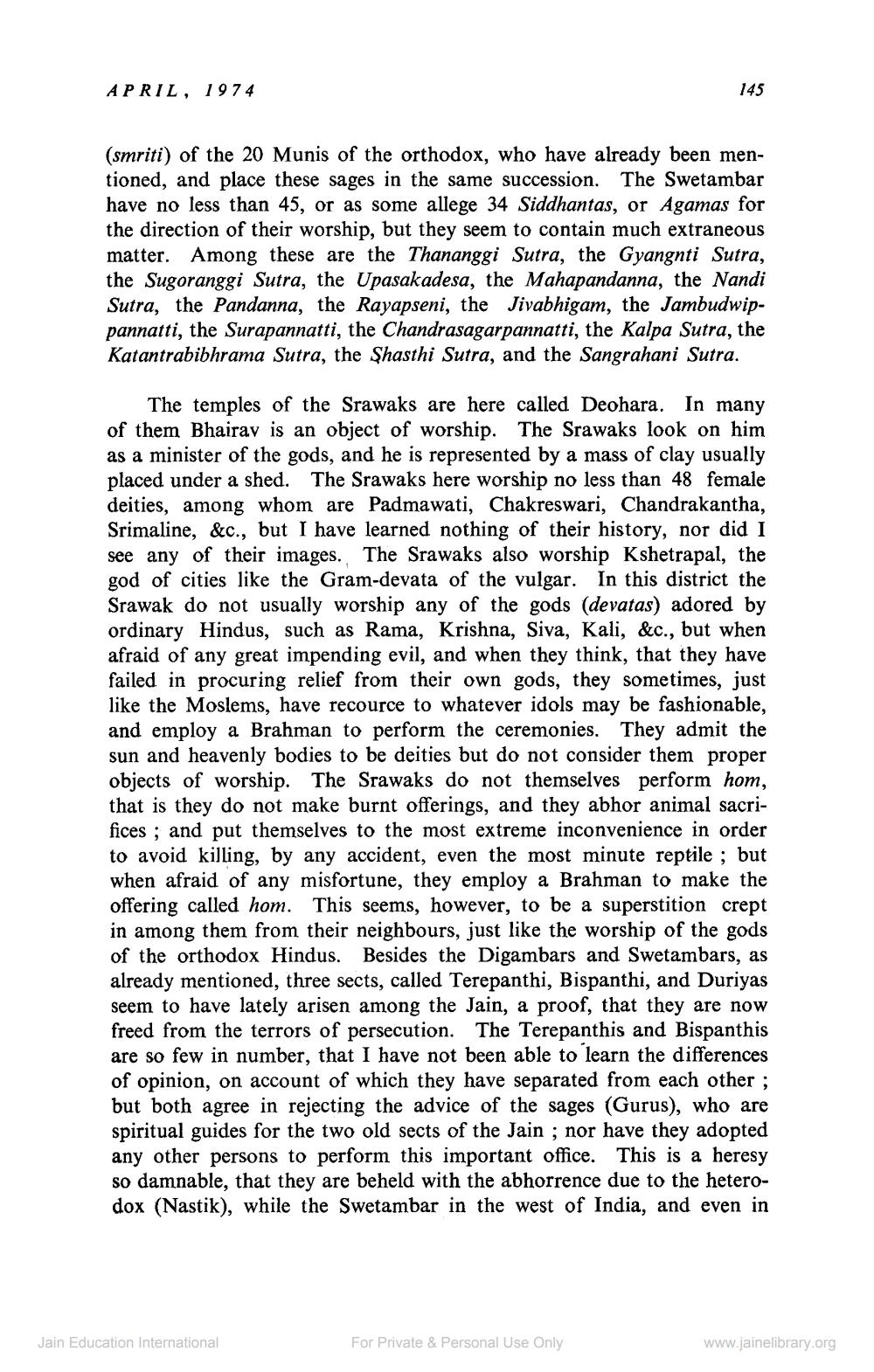Book Title: Jain Journal 1974 04 Author(s): Jain Bhawan Publication Publisher: Jain Bhawan Publication View full book textPage 7
________________ APRIL, 1974 (smriti) of the 20 Munis of the orthodox, who have already been mentioned, and place these sages in the same succession. The Swetambar have no less than 45, or as some allege 34 Siddhantas, or Agamas for the direction of their worship, but they seem to contain much extraneous matter. Among these are the Thananggi Sutra, the Gyangnti Sutra, the Sugoranggi Sutra, the Upasakadesa, the Mahapandanna, the Nandi Sutra, the Pandanna, the Rayapseni, the Jivabhigam, the Jambudwippannatti, the Surapannatti, the Chandrasagarpannatti, the Kalpa Sutra, the Katantrabibhrama Sutra, the Shasthi Sutra, and the Sangrahani Sutra. 145 The temples of the Srawaks are here called Deohara. In many of them Bhairav is an object of worship. The Srawaks look on him as a minister of the gods, and he is represented by a mass of clay usually placed under a shed. The Srawaks here worship no less than 48 female deities, among whom are Padmawati, Chakreswari, Chandrakantha, Srimaline, &c., but I have learned nothing of their history, nor did I see any of their images. The Srawaks also worship Kshetrapal, the god of cities like the Gram-devata of the vulgar. In this district the Srawak do not usually worship any of the gods (devatas) adored by ordinary Hindus, such as Rama, Krishna, Siva, Kali, &c., but when afraid of any great impending evil, and when they think, that they have failed in procuring relief from their own gods, they sometimes, just like the Moslems, have recource to whatever idols may be fashionable, and employ a Brahman to perform the ceremonies. They admit the sun and heavenly bodies to be deities but do not consider them proper objects of worship. The Srawaks do not themselves perform hom, that is they do not make burnt offerings, and they abhor animal sacrifices; and put themselves to the most extreme inconvenience in order to avoid killing, by any accident, even the most minute reptile; but when afraid of any misfortune, they employ a Brahman to make the offering called hom. This seems, however, to be a superstition crept in among them from their neighbours, just like the worship of the gods of the orthodox Hindus. Besides the Digambars and Swetambars, as already mentioned, three sects, called Terepanthi, Bispanthi, and Duriyas seem to have lately arisen among the Jain, a proof, that they are now freed from the terrors of persecution. The Terepanthis and Bispanthis are so few in number, that I have not been able to learn the differences of opinion, on account of which they have separated from each other; but both agree in rejecting the advice of the sages (Gurus), who are spiritual guides for the two old sects of the Jain; nor have they adopted any other persons to perform this important office. This is a heresy so damnable, that they are beheld with the abhorrence due to the heterodox (Nastik), while the Swetambar in the west of India, and even in Jain Education International For Private & Personal Use Only www.jainelibrary.orgPage Navigation
1 ... 5 6 7 8 9 10 11 12 13 14 15 16 17 18 19 20 21 22 23 24 25 26 27 28 29 30 31 32 33 34 35 36 37 38 39 40 41 42 43 44 45 46 47 48 49 50 51 52 53 54 55 56 57 58 59 60 61 62 63 64 65 66 67 68 69 70 71 72 ... 107
